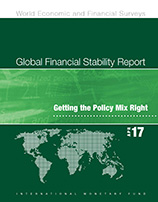Summary
Chapter 1: Getting the Policy Mix Right
Chapter 1 finds that financial stability has continued to improve since the October 2016 Global Financial Stability Report. Economic activity has gained momentum and longer-term interest rates have risen, helping to boost earnings of banks and insurance companies and improving appetite for risk. Despite this improvement, new threats to financial stability are emerging from elevated political and policy uncertainty around the globe. If policy developments in advanced economies mean a less benign path for growth and debt than expected, risk premiums and volatility could rise sharply, undermining financial stability. In addition, a shift toward protectionism in advanced economies could reduce global growth and trade, impede capital flows, and dampen market sentiment. Getting the policy mix right is crucial. In the United States, policymakers should provide incentives for economic risk taking, while guarding against excessive financial risk taking that could undermine financial stability. Emerging market economies should address domestic imbalances while protecting themselves from external shocks. In Europe, banking systems face structural challenges that need to be tackled. The postcrisis reform agenda has strengthened oversight of the financial system, raised capital and liquidity buffers of individual institutions, and improved cooperation among regulators. Caution is needed when considering any rollback of this progress.
Chapter 2: Low Growth, Low Interest Rates, and Financial Intermediation
Chapter 2 analyzes the potential long-term impact of a scenario of sustained low growth and low real and nominal rates for the business models of financial institutions and the products offered by the financial sector. Advanced economies have experienced low interest rates and growth since the global financial crisis. Despite recent signs of an increase in longer-term yields, an imminent exit from low rates is not guaranteed, given the prevalence of slow-moving structural factors, such as demographic aging and stagnation in productivity growth. The confluence of these factors could change the nature of financial intermediation. Credit demand would likely be lower whereas household demand for transaction services would likely rise. Consequently, banking in advanced economies may evolve toward fee-based services. Aging will increase demand for health and long-term-care insurance, and low asset returns would accelerate the transition to defined-contribution private pension plans. Demand is likely to weaken for long-term savings products offered by insurers in favor of passive index funds. Policies could help ease the adjustment to such an environment by providing incentives to ensure longer-term stability instead of merely attenuating short-term pain.




